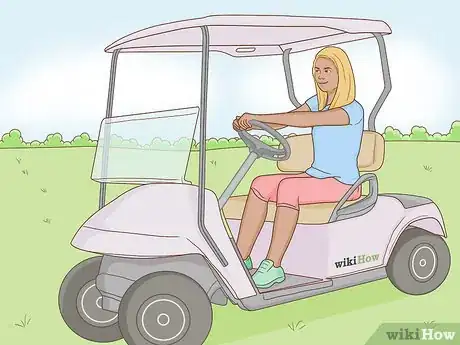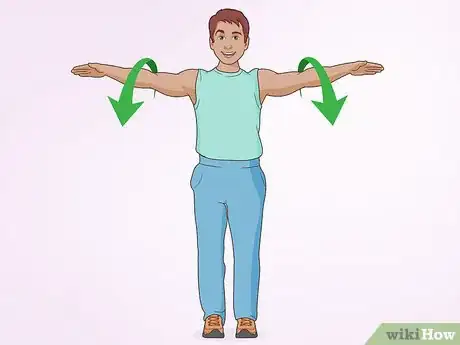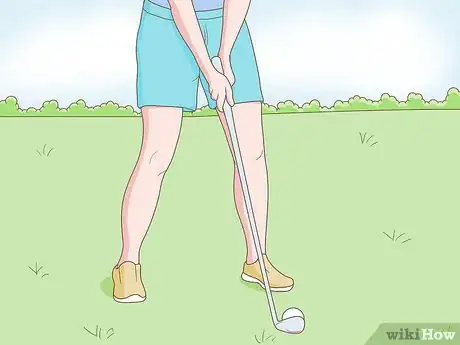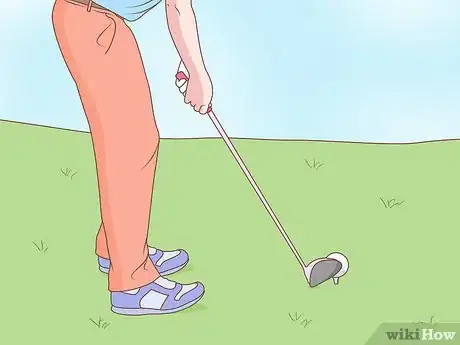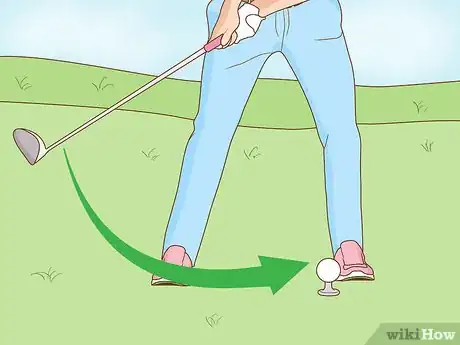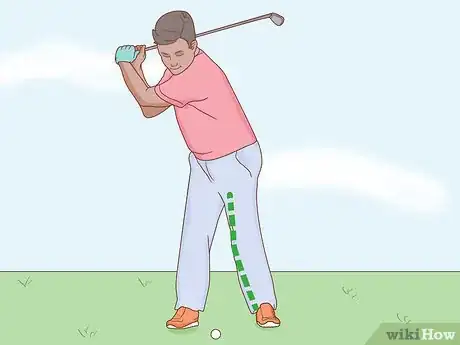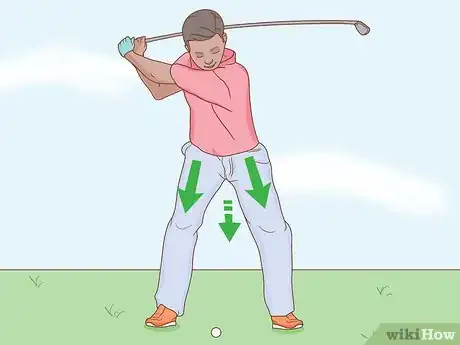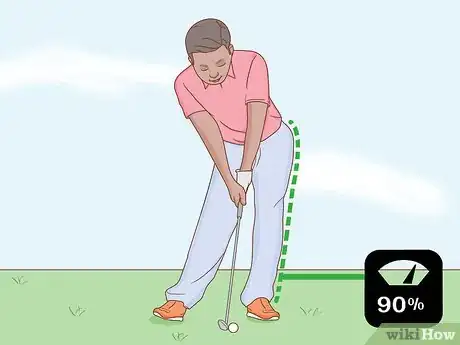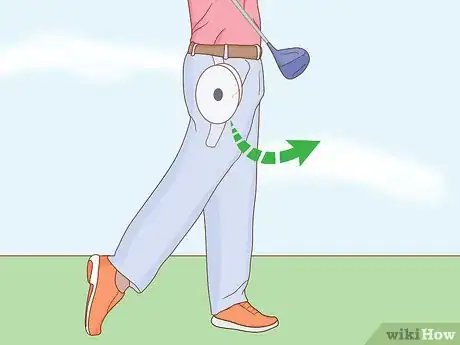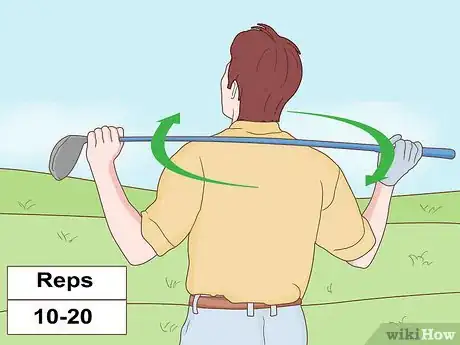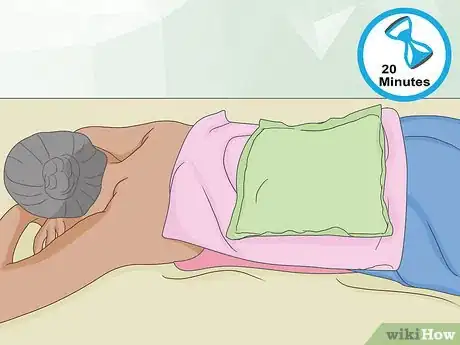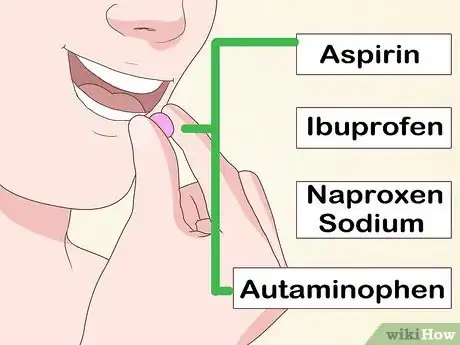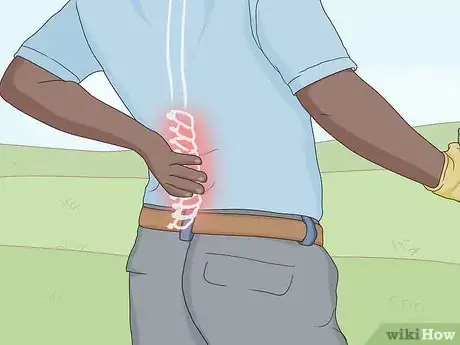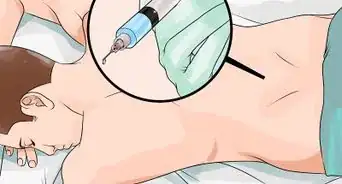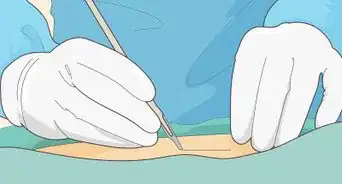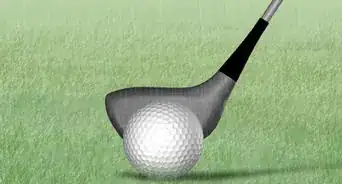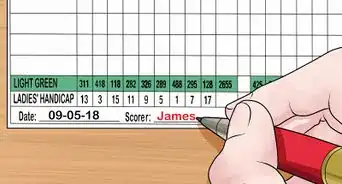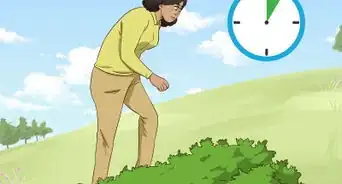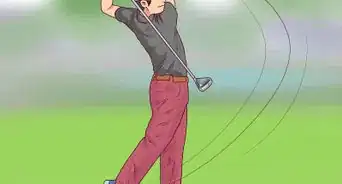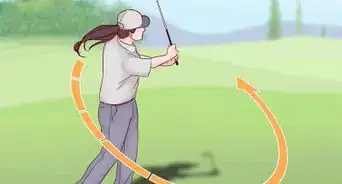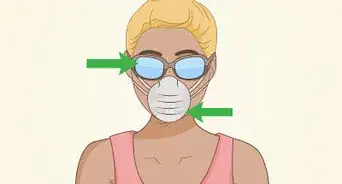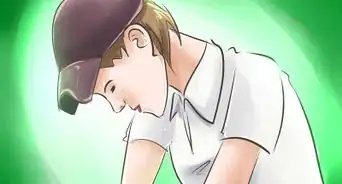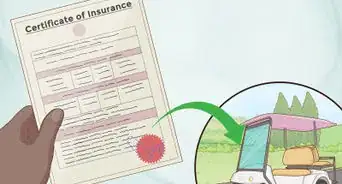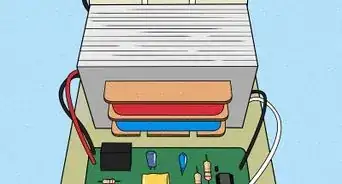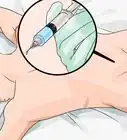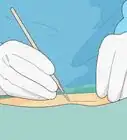This article was co-authored by Cassie Wakin. Cassie Wakin is a Pain & Posture Specialist based in Austin, Texas. With more than 11 years of experience, she specializes in fitness coaching, intuitive eating nutrition counseling, and addressing back pain, poor posture, and joint pain. Cassie holds a Human Biomechanics Specialist Certification from Functional Patterns and is an Anthem Award winning trainer.
There are 12 references cited in this article, which can be found at the bottom of the page.
This article has been viewed 120,280 times.
Golf players are often familiar with the saying: "There are two kinds of golfers...those with back problems and those that are gonna have back problems."[1] Back pain doesn’t need to mean putting away your beloved clubs. You can still have a nice day on the back nine even if your back hurts. You can play golf with back pain by adjusting your game and relieving your discomfort.
Steps
Adjusting Your Game
-
1Work with a golf pro. Find a PGA, or Pro Golfer’s Association, a golf pro in your local area.[2] Let the pro know where you’re having back pain and how you’ve tried to ease it. Because certified PGA pros understand the biomechanics of the game and the muscles and joints involved in it, they can make suggestions on how best to adjust your game if you have pain. This can keep you on the links for the long haul.[3]
-
2Drive the course in a cart. Rent a golf cart for yourself on days you play a full or half course. Driving around the course can spare your back additional pain from carrying or pulling around heavy clubs.[4]
- Ask a friend or hire a golf caddy to help you lift your clubs in and out of the cart.
Advertisement -
3Warm up your body before any game. Perform a few exercises such as arm circles before taking any practice swings or starting your game.[5] Doing specific exercises can warm up your muscles, ease discomfort, and prevent further injury to your back. Try 15-seconds each of the following warm up exercises for golfers:[6]
- Arm circles
- Overhead extensions
- Overhead side bends
- Partial squats
- Side lunges
-
4Do a few practice swings. Pull out the putter you’ll use most during your game. Practice a few slow and easy swings with the putter until you feel more flexible. After about 15-30 practice putts, add a few chips, pitches, and flops to round out your warm up swings. This may feel repetitive, but it helps your body to slowly regain the necessary movements to play. It may also ease some discomfort.[7]
- Keep the tempo of your swing slow for at least the first 15 swings of each set. Gradually build up to full tempo swings by your final few in each set.
-
5Stand on even surfaces. Seek out surfaces that are flat for each hole and when you swing. Maintaining balance on even surfaces ensures adequate hip rotation and can improve your mobility and stabilize your spine. It may also reduce or prevent further pain during your game.[8]
- Avoid putting, swinging, or climbing in and out of sand traps, which can cause you pain and affect your mobility and stability.
Using Proper Form Through Your Golf Swing
-
1Reduce your swing length. Using proper body positioning in the backswing, downswing, impact, and finish of each can ease your discomfort and prevent further pain. If you’re just starting a game or are coming back from an injury, decrease how long each swing is. Performing shorter swings can help you maintain your balance, gain mobility gradually and safely, and reduce stress on your back.[9]
-
2Bend the right knee and left shoulder downward for your backswing. As you enter your backswing, keep your right knee bent as you turn your left shoulder downward. This allows you to progress into your downswing in the proper position that can ease discomfort and prevent injury or further pain.[10]
-
3Make a squat move for the downswing. As you move from the backswing into your downswing, engage your thigh and butt muscles by lightly squatting down. You might even feel like you’re about to leap off the ground. Making this gentle squat motion promotes lateral motion that reduces how much you twist your spine and hips. This can ease back pain and prevent further stress or injury to it.[11]
-
4Ensure your body weight is over your left leg at impact. Check to see if about 90% of your body weight is over your left leg as you move from your downswing to hitting the ball. Recognize if your hips and shoulders are becoming level and turning open during the movement. Make adjustments to your back- and downswings if your body weight is over the right leg, which means you used your spine to rotate towards your target. This ensures that you don’t put too much stress on your back or cause additional pain.[12]
-
5Thrust your pelvis toward the target to finish. Push forward with your hips toward your target hole. Then stand up straight as the ball heads towards its target. This can absorb any stress in your back and make each swing more comfortable during your game.[13]
Relieving Pain and Discomfort
-
1Stretch your back and body regularly. Talk to your doctor or physical therapist about stretches that can ease your back pain. Before and after each game, perform these stretches or others that target your back muscles. Doing these can ease your pain, prevent further injury, and loosen your back muscles. Not every stretch will work for every body or be optimal for certain types of back pain, but consider the following stretches:[14]
- Stretch the shoulder by holding a golf club behind your neck and shoulders. Grasp both ends of the club with your hands and rotate your torso gently from side to side from your hips for 10-20 reps.
- Stretch the hips by lying down on the floor and pulling one knee to your chest. Return the leg to the floor and repeat with the opposite knee. Perform 10-20 reps.
- Stretch the hamstrings by bending over touching your toes. If you can’t reach the floor, simply allow your body to hang over your legs for 10-30 seconds.
- If you feel more pain by stretching or the situation doesn't improve, discuss your situation with a doctor. Depending on the circumstances, the wrong stretch exercise can worsen your pain.
-
2Ice your back before your game. Use an ice pack or a bag of frozen vegetables on you back 30-60 minutes before you play golf. Keep it on your back for 20 minutes and then remove it. Icing your back before a golf game can reduce swelling and inflammation that cause pain. This may allow you to fully enjoy your game with less or even no pain.[15] Use a towel between the ice pack and your skin to help prevent frostbite.[16]
- Freeze a foam cup full of water and gently massage it into your back for 20 minutes.
- If your skin gets too cold or numb, remove the ice.
-
3Take an over-the-counter pain medication. Pop an over-the-counter pain medication such as ibuprofen or acetaminophen to relieve your back pain and discomfort. Some, such as naproxen sodium and ibuprofen, may even ease swelling and inflammation in your back. Following dosing instructions to keep you comfortable during your entire golf gain. Take any of the following pain meds to relieve back pain:[17]
- Aspirin
- Ibuprofen
- Naproxen sodium
- Acetaminophen
-
4Listen to your body. Avoid pushing yourself too much during your golf game. Play as many holes as you are comfortable and take frequent breaks. Pay attention to signs of severe pain and stop your game to prevent further discomfort or injury.
Expert Q&A
-
QuestionHow do you release a tight back?
 Cassie WakinCassie Wakin is a Pain & Posture Specialist based in Austin, Texas. With more than 11 years of experience, she specializes in fitness coaching, intuitive eating nutrition counseling, and addressing back pain, poor posture, and joint pain. Cassie holds a Human Biomechanics Specialist Certification from Functional Patterns and is an Anthem Award winning trainer.
Cassie WakinCassie Wakin is a Pain & Posture Specialist based in Austin, Texas. With more than 11 years of experience, she specializes in fitness coaching, intuitive eating nutrition counseling, and addressing back pain, poor posture, and joint pain. Cassie holds a Human Biomechanics Specialist Certification from Functional Patterns and is an Anthem Award winning trainer.
Pain & Posture Specialist That is really individual. Everybody's got different biomechanical deficiencies, and looking at somebody's posture and assessing exactly why they might have back pain is going to be instrumental in getting permanent relief. There really is no quick fix or one-size fits all that works for everybody, so maybe try checking your specific situation with a doctor before trying anything that might make it worse.
That is really individual. Everybody's got different biomechanical deficiencies, and looking at somebody's posture and assessing exactly why they might have back pain is going to be instrumental in getting permanent relief. There really is no quick fix or one-size fits all that works for everybody, so maybe try checking your specific situation with a doctor before trying anything that might make it worse. -
QuestionHow do I pick up the ball safely?
 TheGrailOfKnowledgeCommunity AnswerPerhaps try to squat down with your knees bending to avoid bending your spine. This is kind of like the way you pick up a shotput if you get confused about how to do it.
TheGrailOfKnowledgeCommunity AnswerPerhaps try to squat down with your knees bending to avoid bending your spine. This is kind of like the way you pick up a shotput if you get confused about how to do it.
References
- ↑ http://pubs.royle.com/article/G5_Marketing%2C_LLC%3A_Creator_Of_MagneCaddy/1470757/169594/article.html
- ↑ https://www.pga.org/directory
- ↑ https://www.ncbi.nlm.nih.gov/pmc/articles/PMC3899905/
- ↑ https://www.ncbi.nlm.nih.gov/pmc/articles/PMC3899905/
- ↑ https://www.hss.edu/golfportal/modifications-for-golfers-with-back-pain.htm
- ↑ http://www.pgaprofessional.com/golf_tips_warmup_print.html#.WW8nM9OGOt8
- ↑ https://www.spine-health.com/conditions/sports-and-spine-injuries/preventing-low-back-pain-golf
- ↑ https://www.hss.edu/golfportal/modifications-for-golfers-with-back-pain.htm
- ↑ https://www.hss.edu/golfportal/modifications-for-golfers-with-back-pain.htm
- ↑ http://www.golfdigest.com/story/save-your-back-foley
- ↑ http://www.golfdigest.com/story/save-your-back-foley
- ↑ http://www.golfdigest.com/story/save-your-back-foley
- ↑ http://www.golfdigest.com/story/save-your-back-foley
- ↑ http://www.spine-health.com/conditions/sports-and-spine-injuries/preventing-low-back-pain-golf
- ↑ http://www.mayoclinic.org/diseases-conditions/tendinitis/basics/lifestyle-home-remedies/con-20020309
- ↑ http://www.orthoinfo.aaos.org/topic.cfm?topic=A00147
- ↑ https://www.healthychildren.org/English/health-issues/injuries-emergencies/sports-injuries/Pages/Treating-Sports-Injuries-with-Ice-and-Heat.aspx

